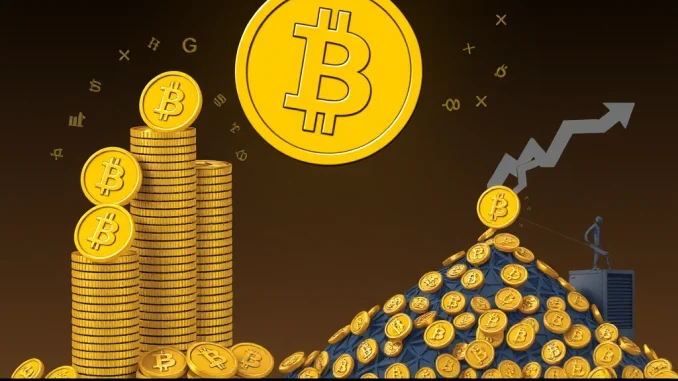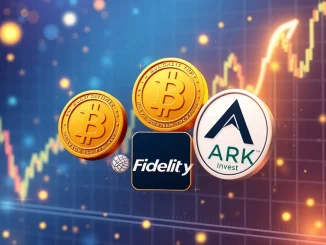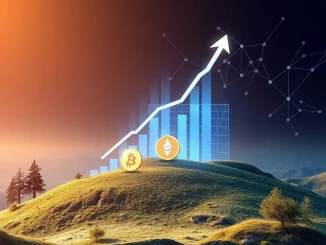
Get ready for a striking statistic that highlights the immense demand building in the Bitcoin market. US spot Bitcoin ETFs are making waves, and their recent activity paints a clear picture of how traditional finance is interacting with the crypto world. Last week alone, these investment vehicles acquired a staggering amount of BTC, far exceeding the pace at which new Bitcoin is entering circulation.
What Are US Spot Bitcoin ETFs and Why Are They Buying So Much?
Let’s break it down. US spot Bitcoin ETFs are exchange-traded funds that directly hold Bitcoin as their underlying asset. Approved by the U.S. Securities and Exchange Commission (SEC) in January 2024, these funds allow investors to gain exposure to the price movements of Bitcoin without having to buy, hold, and secure the actual cryptocurrency themselves. This accessibility has opened the floodgates for institutional investors, wealth managers, and even retail investors who prefer regulated investment products.
The primary reason for their significant purchasing activity is simple: investor demand. When investors buy shares of a spot Bitcoin ETF, the fund manager must acquire an equivalent amount of actual Bitcoin to back those shares. The more money flows into these ETFs, the more Bitcoin they need to buy from the open market or through over-the-counter (OTC) desks.
Consider these points about their impact:
- **Accessibility:** They lower the barrier to entry for traditional investors.
- **Liquidity:** ETF shares are easily traded on major stock exchanges.
- **Custody:** The complex task of securing Bitcoin is handled by professional custodians.
- **Institutional Gateway:** They provide a regulated pathway for large institutions to allocate capital to Bitcoin.
Comparing BTC Buying vs. BTC Mined: The Astonishing Imbalance
Here’s where the recent data gets truly compelling. According to reports, US spot Bitcoin ETFs collectively purchased 18,644 BTC over the past five trading days. To put this into perspective, let’s look at the supply side. During that same period, approximately 3,150 BTC were mined and added to the total Bitcoin supply. This means the buying activity from these ETFs was about six times greater than the new supply created by miners.
Bitcoin mining is the process by which new Bitcoin is created and transactions are verified. Miners use powerful computers to solve complex mathematical problems, and the first miner to solve the puzzle for a block is rewarded with a set amount of new Bitcoin (the block reward) plus transaction fees. The block reward recently halved in the April 2024 halving event, reducing the rate of new Bitcoin entering circulation from 6.25 BTC per block to 3.125 BTC per block.
This stark contrast between the rate of BTC buying by ETFs and the rate of new BTC mined highlights a significant supply-demand dynamic currently at play in the market. While the total inflow for the past five trading days reached around $1.8 billion, it’s worth noting that these flows aren’t always positive. Farside Investors data indicated a net outflow on April 30th, demonstrating that market sentiment and investor behavior can cause fluctuations in ETF holdings.
What Does This Mean for the Bitcoin Supply and Price?
The core implication of ETFs buying significantly more Bitcoin than is being mined is the potential for a supply shock. Bitcoin’s supply is famously finite (capped at 21 million coins), and the rate at which new Bitcoin is produced is predictable and decreases over time due to halving events. When demand from major players like ETFs consistently outstrips the rate of new supply, it puts upward pressure on the price.
Think of it like this: If everyone wants to buy oranges, but the orange groves are only producing a limited number each week, and a few big buyers come in and purchase several weeks’ worth of production in one go, the price of oranges is likely to rise because there isn’t enough supply to meet the sudden surge in demand.
While ETF flows are just one factor influencing Bitcoin’s price (others include macroeconomic conditions, regulatory news, and market sentiment), their substantial buying power cannot be ignored. They represent a significant new source of demand that wasn’t present before January 2024.
Are There Challenges or Risks Associated with High ETF Demand?
While the narrative of strong demand is generally positive for price, it’s important to consider potential challenges and risks:
- **Concentration Risk:** A large portion of readily available Bitcoin could become concentrated in the hands of a few large ETF issuers.
- **Market Volatility:** Large inflows can contribute to rapid price increases, but equally, significant outflows could lead to sharp price declines if ETFs are forced to sell substantial amounts of BTC.
- **Correlation:** Bitcoin’s price could become more correlated with traditional financial markets and investor sentiment towards ETFs, potentially reducing its appeal as a truly uncorrelated asset.
- **Reliance on Inflows:** The market could become overly reliant on continuous ETF inflows to sustain price levels.
These factors don’t negate the importance of ETF demand, but they add layers of complexity to the market dynamics that investors should be aware of.
Looking Ahead: The Future of US Spot Bitcoin ETFs and BTC Buying
The approval and subsequent performance of US spot Bitcoin ETFs have been a watershed moment for the cryptocurrency market. They have brought Bitcoin into the mainstream of traditional finance and provided a robust, regulated channel for significant capital inflows. The data showing their immense appetite for Bitcoin supply, far exceeding the rate of new BTC mined, underscores the potential for these products to fundamentally alter the supply-demand balance.
As these ETFs mature and potentially attract even more investment, their impact on the market will continue to be a key area of focus. While short-term fluctuations in inflows and outflows will occur, the underlying trend of substantial institutional and retail interest facilitated by these products appears set to continue shaping the future of Bitcoin.
Conclusion: A New Era of Demand
The statistic is clear: US spot Bitcoin ETFs are consuming Bitcoin at a pace that dwarfs new production. This powerful surge in BTC buying represents a new era of demand, largely driven by increased accessibility for traditional investors. While challenges exist, the sheer volume of Bitcoin being acquired by these funds relative to the amount being mined is a critical factor influencing the market today and highlighting the increasing mainstream adoption of Bitcoin as a legitimate asset class. Keeping an eye on ETF flows will be essential for understanding market movements going forward.



